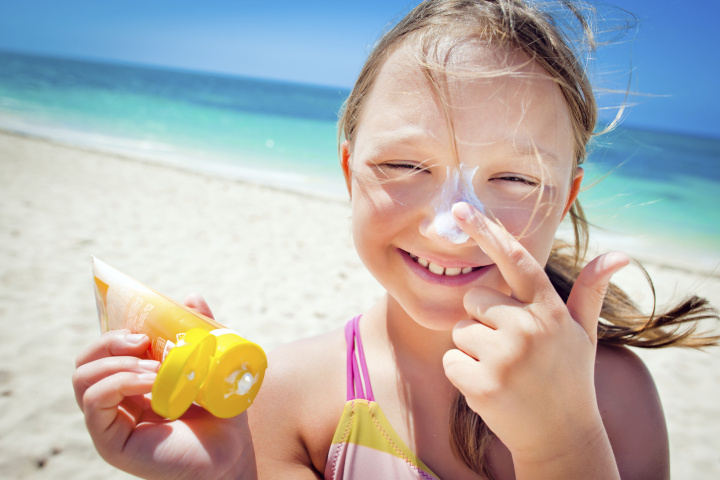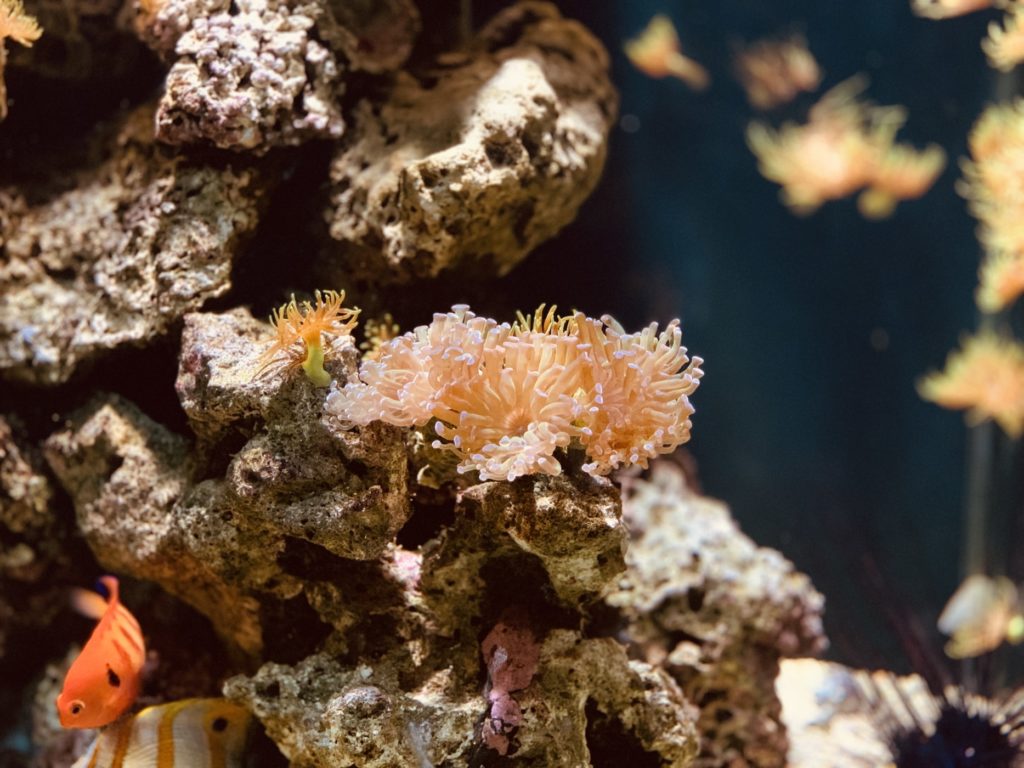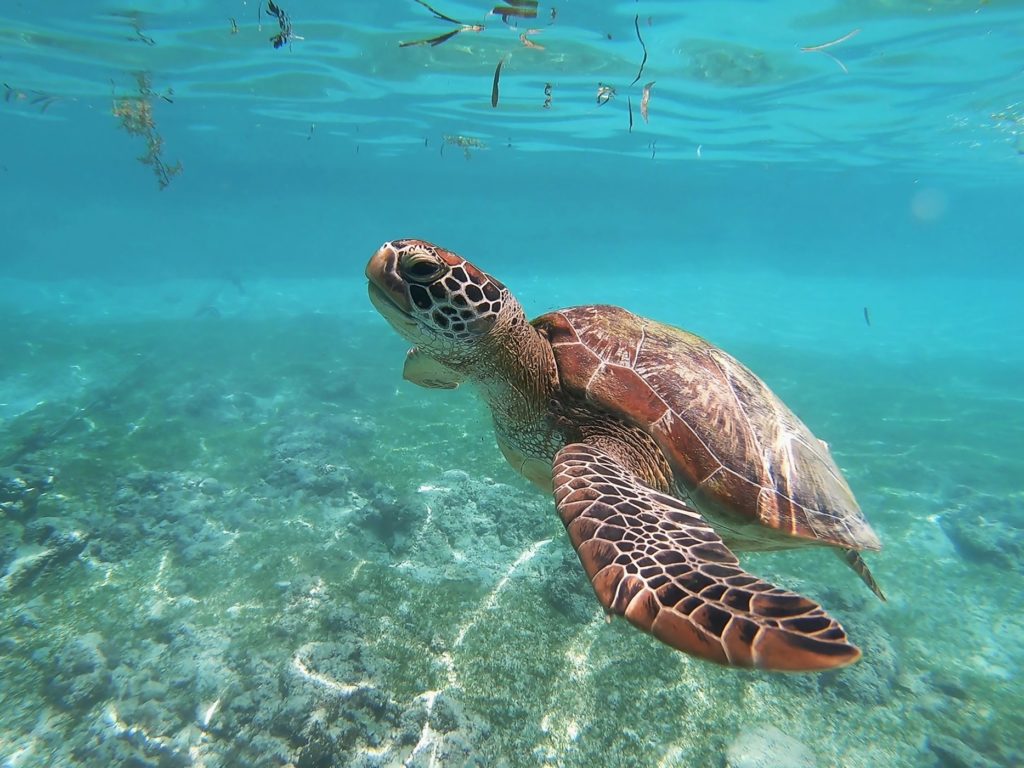If health experts and beauty gurus agree on one piece of advice, it’s this: Don’t leave the house without sunscreen. Especially to those living in the Sunshine State, wearing sunscreen is sacrosanct, a regimen many Floridians do without thinking. But as is the case with most personal-care products, sunscreen has fallen under scrutiny among researchers and scientists, who say that many of its products include chemicals that bleach coral reefs.
The majority of chemical-based sunscreens contain oxybenzone and octinoxate, two of the most commonly used UV blockers worldwide. Over the past couple of years, however, these ingredients have received a bad rep, due to their potentially reef-damaging effects. The negative press stems from a 2016 study written by Craig Downs, a forensic ecotoxicologist and the executive director of Haereticus Environmental Laboratory, who found that coral exposed to oxybenzone and octinoxate exhibited severe signs of distress—including abnormal skeletal growth, endocrine disruption, DNA damage and bleaching. Rising ocean temperatures or high amounts of chemicals leached into waterways, such as those from water effluent and runoff, can result in coral bleaching. When this happens, corals turn stark white and expel the symbiotic algae living in their tissues. While corals can survive a bleaching event, without their algae counterpart they are less resilient to environmental threats and more susceptible to death.
Corals are disappearing at a rapid clip across the globe. The Caribbean, for instance, has lost 80% of its reefs to coastal development, pollution and warming waters. These factors are more difficult to mitigate; with ever-growing populations and the subsequent reliance on fossil fuels to supply cities with fuel and electricity, saving marine ecosystems from climate change will demand a major overhaul in environmental policies. Choosing an eco-friendly sunscreen, on the other hand, is a simple measure—and it’s one that has already gained momentum politically.
This October, Florida state senator Linda Stewart proposed a bill, SB318, that would require a prescription to use sunscreens with oxybenzone and octinoxate. If approved, the ban could take effect as early as July 2020. The bill was modeled after two similar ones in Hawaii and Key West, both of which passed bans on sunscreens containing the two coral-bleaching compounds in question, and are set to go into effect in January 2021.
It’s important to note, researchers and officials are not condoning a ban on all sunscreens—nor do they recommend forgoing sun protection altogether—but rather only on those that pose a threat to coral reef conservation.
Sunscreens designated as “reef safe”—that is, they consist of mostly mineral compounds as opposed to chemicals—would replace environmentally harmful ones on the shelves. But even sunscreens deemed “reef safe” are up for debate. Some studies demonstrate that, under certain conditions, these, too, can cause coral bleaching. For sun-lovers who want to keep their skin—and the environment—healthy, a double bind remains: wear sunscreen and endanger coral reefs, which are vital to tourism economy and aquatic life, or refrain from wearing sunscreen and increase the risk of skin cancer.
With all the conflicting research on sunscreens
surfacing lately, what’s the right choice?

Are sunscreens harmful—to humans?
Now, luckily, titanium and zinc have been micronized into sheerer formulas, but they still leave a noticeable white film—even after a vigorous rub into the skin. Chemical sunscreens, on the other hand, yield a virtually invisible sheen (albeit a greasy one). Made of chemical, or organic, ingredients—primarily oxybenzone, octinoxate, avobenzone and PABA—these sunscreens often appear in cosmetic and skincare products, such as moisturizers and makeup. Unlike mineral sunscreens, which work topically, chemical sunscreens penetrate deep into the skin, through the epidermis and dermis layers, and act as a sponge to absorb UV rays before they can cause serious damage.
While both sunscreen types are available on the market, only those containing the ingredients zinc oxide and titanium dioxide are “generally recognized as safe and effective” by the Food and Drug Administration. This February the agency released a final sunscreens monograph, calling for a reevaluation of 12 UV filters allowed for use in the U.S.—including the two that SB318 would ban. The report, in a nutshell, states that not enough data exist to determine whether these 12 ingredients are safe. In particular, the FDA raised concerns about the absorption characteristics of oxybenzone—namely, its ability to mimic hormone levels and to enter the bloodstream through the skin. (Some researchers have even found detectable levels in breast milk.) Oxybenzone can also cause sunscreen-related skin allergies with frequent use. Dr. Cathleen London, an assistant professor of medicine at Weill Cornell Medical College, recently told Harper’s Bazaar that certain chemicals in sunscreens can actually “cause free radical formation, which leads to more sun damage in the long run.”
Despite the ambiguities surrounding chemical sunscreens—their suspect nature of absorption, their potential toxic effects on the body long after application—the FDA advises consumers not to swear off sunscreen altogether. Chemical sunscreens, the agency seems to say, are better than no protection at all. According to the U.S. Centers for Disease Control and Prevention, skin cancer is the most common form of cancer in the U.S. And numbers continue to climb: In 2016, 82,000 people were diagnosed with skin cancer, an increase from 60,000 in 2009. The CDC reports that Florida ranks second in the country as having the highest rates of melanoma, largely due to its proximity to the equator, where UV rays are the strongest.
If wearing SPF is a safeguard against skin cancer, then, are Floridians consigned to pasty mineral sunscreens, the supposed healthier, reef-safe option? Or does such an alternative even exist?

Reef safe? Think again.
Coral reefs do more than cast an array of vibrant colors against the crystal blue backdrop of the ocean, making them appear as mystical gardens of the sea. They serve as a natural redoubt against shoreline erosion, storm
damage and marine degradation, by absorbing nearly all of a wave’s energy. They’re also home to 25% of all
marine life and account for an economic value of $3.4 billion each year in tourism, fisheries and coastal protection. With an estimated one billion people expected to visit beaches worldwide in 2020, the damaging
effects of sunscreens on marine environments has the potential to increase significantly. Which makes choosing the right sunscreen all the more important.
In an interview with The New York Times, Craig Downs, the lead author of the aforementioned 2016 study on sunscreens and coral-bleaching, said that the chemicals in sunscreen that wash into water bodies from swimming and showering pose a bigger threat to corals than climate change. He noted, however, to think twice before buying reef-safe sunscreens. Scientists have yet to come up with an agreed-upon definition of the term, which means that products labelled “reef-safe” are not government regulated, and thus do not require manufacturers to test for the detriment they impose on aquatic life—or on human health. Even if they did employ such tests, and the product passed, he explained, that doesn’t prove that the chemicals in reef-safe products couldn’t produce toxic effects in high enough concentrations.
“You would have to do an ecological risk assessment on that product, and you would have to show that, at a reasonable, rational concentration, at a specific reef, that it wasn’t harmful to the ecosystem as a whole,” Downs told Pacific Standard, in April. He added: “‘Reef-safe’ is a marketing claim. I don’t know of a single government that demands a ‘reef-safe’ product.” According to marine ecology researcher Cinzia Corinaldesi, who has been studying the effects of sunscreens on reefs since 2003, SPF products that tout minerals such as zinc and titanium are no safer for the environment than chemical-based ones.
In a 2018 study, she put these so-called reef-friendly sunscreens to test, analyzing how uncoated zinc and titanium nanoparticles interact with coral reefs. Her results demonstrated that zinc caused “severe and fast coral bleaching due to the alteration of the symbiosis between coral and zooxanthellae,” otherwise known as symbiotic algae, whereas titanium showed minimal impacts on both corals and symbiotic interactions. “Unfortunately, despite several cosmetic products and sunscreens available in the market are defined ‘reef-safe’ or ‘eco-friendly’ or ‘biodegradable,’ they are not so, and indeed lack specific tests on marine organisms,” she explained to Smithsonian in a 2018 interview.
Adding to the confusion, some resources say to look for mineral sunscreens with non-nanoparticles—that is, particles above 100 nanometers in size. Because non-nano ingredients have larger particles, they’re not as easily absorbed into tissues (both in humans and in corals) as, say, micronized chemical formulas. While a glossy sheen may look more attractive at the beach, the white, chalky sunscreens are, by and large, safer for corals and surrounding underwater ecosystems.
Still, the U.S. government has not enforced regulations on sunscreens, and FDA rules approve any type of zinc and titanium, so claims about the absorption characteristics of various sized nanoparticles are misleading. Even with existing uncertainties about which sunscreens are indeed environmentally safe, research groups tend to favor mineral formulas with coated, non-nanoparticles (preferably larger than 150 nanometers). Until the FDA enacts stricter guidelines and recommendations on zinc and titanium, along with other UV filters available on the U.S. market, staying on top of the latest sunscreen research, and regularly checking consumer reports, seems to be the best option.

Here’s how to protect your skin and the environment:
- Stay informed: Haereticus Environmental Lab publishes a list each year of what sunscreens are safe for the environment, and the Environmental Working Group, a consumer activist nonprofit that has pushed the FDA for more in-depth studies on sunscreen, rates SPF products on their environmental impact. Check out their 2019 sunscreen guide here.
- Steer clear of chemical sunscreens: While sun protection is key to preventing skin cancer, there are hundreds of mineral alternatives to chemical sunscreens. To be sure, more research is needed to determine which are the best mineral sunscreens for the environment, but these formulas offer the lesser of two evils. With beach-friendly weather soon approaching—which, in Florida, that means February—try a few mineral-based options and see which ones work for you. Most important, show your support for SB318, and take a stand in banning chemicals that bleach coral reefs.
- Go for the simplest option: Downs recommends not to overcomplicate the sunscreen-buying process. Certain organic ingredients, such as eucalyptus and lavender and beeswax, can be dangerous to the skin and the environment when broken down or emulsified. A good rule of thumb, he says: Keep it simple.
- Skip the spray: Opt for lotions and creams instead of aerosols, which often stick more to the sand than your skin. This chemical-coated sand can later wash into the ocean and contaminate corals and marine habitats. Worse, these chemicals can also sink deeper into the sand when it rains, causing harm to the species and sea turtle eggs that nest underground.
- Take a break in the shade: If you’re planning a day at the beach, seek cover in a shady spot, between 11 a.m. and 2 p.m., when the sun’s rays are the strongest. Don’t want to forgo precious sun time? Try sunbathing under a beach tent or beach umbrella, using only one application of sunscreen. The less sunscreen you apply means—you guessed it!—less of it will end up in the ocean.
- Make an eco-friendly fashion statement: Peruse the internet for sun protective clothing and you’re likely to find apparel with a UPF (ultraviolet protection factor) rating. These work similarly to SPF ratings in sunscreens. Clothing, no doubt, provides the best sun protection, but it does leave some parts of the body exposed. Coolibar, a sun-protective fashion line, sells a UV face mask that covers the face from the eyes down. But who wants to wear a balaclava or something that resembles a beekeeper veil to the beach? Swim shirts, sundresses, rash guards or one of those floppy, fashionable sun hats will do the trick. Worried about fast fashion? Check thrift stores for sun-protective clothing before you buy new. The point is to find an option that works for you and stick with it.
Sources:
https://pubchem.ncbi.nlm.nih.gov/compound/Oxybenzone
https://pubchem.ncbi.nlm.nih.gov/compound/5355130
https://www.ncbi.nlm.nih.gov/pubmed/26487337
https://oceanservice.noaa.gov/facts/coral_bleach.html
https://www.theguardian.com/environment/2013/aug/01/caribbean-coral-reef-loss
https://www.cnn.com/2019/10/16/health/florida-sunscreen-ban-coral-reefs-trnd/index.html
https://www.flsenate.gov/Session/Bill/2020/318
https://www.mustelausa.com/mineral-vs.-chemical-sunscreen
https://forefrontdermatology.com/chemical-vs-physical-sunscreen/
https://www.fda.gov/media/124655/download
https://www.ewg.org/sunscreen/report/the-trouble-with-sunscreen-chemicals/
https://psmag.com/environment/is-your-sunscreen-harming-coral-reefs
https://www.harpersbazaar.com/beauty/skin-care/advice/a10775/chemical-versus-physical-sunscreen/
https://www.cdc.gov/cancer/skin/statistics/index.htm
https://gis.cdc.gov/Cancer/USCS/DataViz.html
https://coast.noaa.gov/states/fast-facts/coral-reefs.html
https://www.consumerreports.org/sunscreens/the-truth-about-reef-safe-sunscreen/
https://www.ncbi.nlm.nih.gov/pubmed/29801220
https://www.ewg.org/sunscreen/report/nanoparticles-in-sunscreen/








